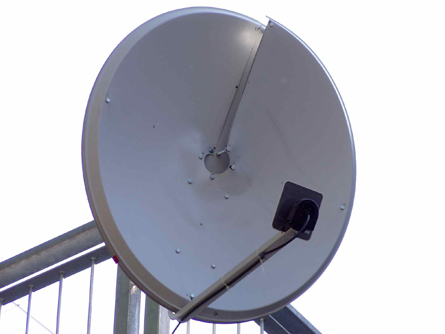Broadcasting live from Italy: a new twist on radio that could pack more information into the airwaves.


Scientists have demonstrated a way to mold radio waves into spirals that could allow multiple radio stations to broadcast at the same frequency. Two waves with different shapes can carry different information without overlapping or interfering with each other.
That’s good news not only for classic rock ’n’ roll, but for wireless networks and cell phones. These technologies communicate in the increasingly crowded radio frequencies, which lie between 3 Hz and 300 GHz.
“We think we can increase the bandwidth by an order of magnitude,” says Fabrizio Tamburini, an astronomer at the University of Padua in Italy, whose team describes their recent experiment in a paper submitted to the New Journal of Physics. This tenfold boost in capacity could help new wireless devices communicate without interfering with each other.
On the night of June 24, Tamburini and colleagues beamed two radio signals from a lighthouse on San Giorgio Maggiore, an island just offshore of Venice. The first encoded a pure tone in a traditional radio wave with peaks and troughs lined up neatly in a single, two-dimensional plane. The second signal bounced off a dish shaped like a flattened spiral staircase 80 centimeters across. This dish wrapped the electromagnetic radiation into a corkscrew without distorting the information it carried — a second tone with a higher pitch.
The two signals, both broadcast at 2.4 GHz, traveled 442 meters through the air, across open water, and arrived onshore at the Doge’s Palace, which once housed the rulers of Venice. An antenna picked up the radio waves, disentangling them like strands of woven rope. A crowd gathered below to hear the sounds, says Tamburini.
“Similar things have been done before using optical vortices and visible light, but not, to my knowledge, using radio waves,” says Grover Swartzlander, a physicist at the Rochester Institute of Technology in New York.
In theory, an infinite number of waves with different twists, or vorticities, can travel together amicably. Tamburini says he’s aiming for a practical, technologically feasible number: 21. Optics researchers weave together hundreds or even thousands of strands of twisted light, the basis of optical tweezers used to manipulate small objects.
The radio researchers hope to miniaturize the technology and create cell phone–sized antennas. The team also plans to try broadcasting over longer distances: 12 kilometers at first, and then 100 kilometers.
That could prove more difficult. In the Venice demonstration, the transmitter and the receiver faced each other across a clear line of sight. Physicist Juan Torres of the Institute of Photonic Sciences in Barcelona, Spain, cautions that messier conditions could distort twisted signals.
“Real transmissions in a smoggy city might represent a technological challenge,” he says.
Tamburini also has an interest in twisted waves coming from the cosmos. In the March Nature Physics, he and his colleagues were the first to predict that rotating black holes twirl passing light. If such an intergalactic broadcast were found, it could provide a new way to test Einstein’s theory of general relativity.







